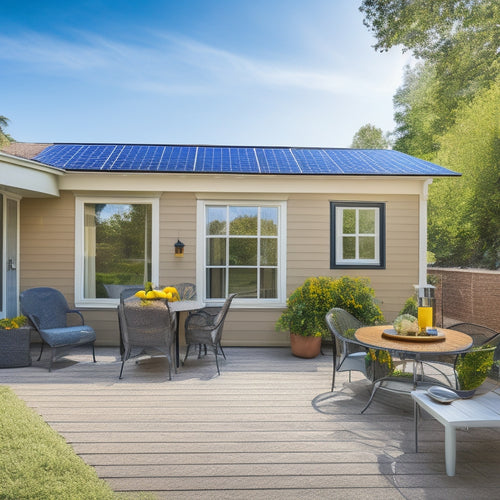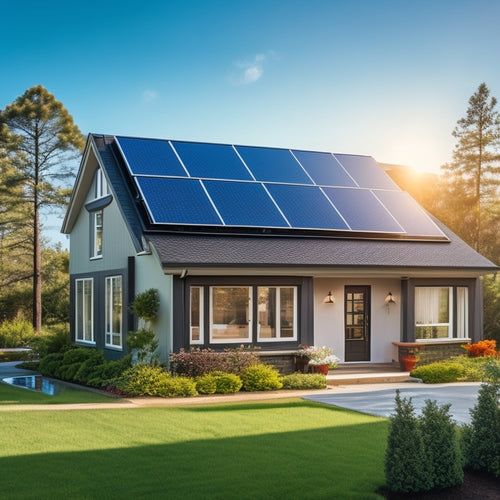
What Happens to Efficiency in Freezing Temperatures?
Share
When you operate equipment in freezing temperatures, you can expect a significant hit to energy output. Machinery and inverters alike experience efficiency losses of up to 15% in cold climates. This is due to increased viscosity of lubricants, decreased conductivity of materials, and snow and ice accumulation interfering with critical components. Inverters are particularly affected, with up to a 10% drop in efficiency during extended cold weather periods. As temperatures drop, you'll need to mitigate these effects to maintain efficiency. Learn how to prepare your equipment and optimize performance in freezing temperatures.
Key Takeaways
• Industrial machinery and equipment experience 10-15% reduction in energy output in cold climates due to lubricant viscosity and material conductivity issues.
• Snow and ice accumulation can reduce absorption of critical components by up to 20% in freezing temperatures, affecting energy production.
• Inverters can experience up to a 10% drop in efficiency during extended cold weather periods due to thermal loss and electrical component impact.
• Freezing conditions can cause micro-cracks in solar panels' photovoltaic cells, leading to material degradation and reduced efficiency.
• Regular inspections are crucial in freezing weather to detect faults or damage before they escalate into major problems and energy losses.
Cold Climates Reduce Energy Output
In cold climates, industrial machinery and equipment typically experience a 10-15% reduction in energy output due to the increased viscosity of lubricants and the decreased conductivity of materials at low temperatures. You know, those frosty mornings when everything seems to move slower? Yeah, that's not just you - it's your equipment too.
As temperatures drop, lubricants thicken, causing machinery to work harder and produce less. It's like trying to run a marathon in quicksand - it's just not happening.
To combat this, you need a solid winterization strategy in place. This means preparing your equipment for the cold months ahead of time, ensuring that lubricants are suitable for low temperatures and that materials can withstand the chill. It's not rocket science, but it does require some planning and attention to detail.
Snow and Ice Interfere With Absorption
As you operate in freezing temperatures, snow and ice accumulation on surfaces can reduce the absorption of critical components, such as solar panels and heat exchangers, by up to 20%. This can be a major issue, especially in regions with heavy snowfall.
The good news is that there are ways to mitigate this effect. One approach is to apply reflective coatings to the surfaces of these components. These coatings can help to minimize the impact of snow and ice by reflecting sunlight and heat, rather than absorbing it.
Another approach is to use de-icing methods, such as heating elements or chemical treatments, to remove snow and ice from the surfaces. By taking these steps, you can help to make sure that your equipment operates at maximum efficiency, even in the coldest temperatures.
Inverter Efficiency Drops in Cold
During extended periods of cold weather, the efficiency of your inverters can drop by up to 10%, resulting in significant losses in energy production. This is because inverters, the devices that convert DC power from your solar panels to AC power for your home, are sensitive to temperature. In cold weather, the inverters' electrical components slow down, reducing their efficiency. This phenomenon is known as thermal loss.
When you start your inverter in freezing temperatures, it's like trying to start a car on a cold winter morning - it takes a little longer to get going. This is known as a cold start. The inverter's internal components need time to warm up, which can lead to energy losses.
The good news is that most modern inverters are designed to operate within a wide temperature range, so the impact of cold temperatures is minimized. However, it's still essential to take into account the potential losses when designing and installing your solar panel system.
Temperature Affects Panel Durability
Extreme temperatures can greatly impact the lifespan of your solar panels, with freezing conditions potentially causing micro-cracks in the photovoltaic cells. You might be thinking, 'What's the big deal? A few tiny cracks won't hurt, right?' Well, not exactly. These micro-cracks can lead to material degradation, which can greatly reduce the overall efficiency of your solar panel system.
Thermal stress is another issue to take into account. When temperatures fluctuate rapidly, the materials in your solar panels expand and contract, causing mechanical stress. This stress can lead to delamination, which is when the layers of the photovoltaic cell separate. It's like when you leave your favorite coffee mug in the freezer and it cracks - not ideal.
As a solar panel owner, you want to make sure your system is running at top levels. When freezing temperatures cause material degradation and thermal stress, you can bet your bottom dollar that your energy output will take a hit.
Maintenance Challenges in Freezing Weather
You'll face additional maintenance challenges when freezing weather sets in, as snow and ice accumulation can conceal potential issues with your solar panel system. Keeping up with maintenance is crucial to guarantee that your system operates effectively, even in the chilliest of temperatures.
Icy roads and frosty connections can lead to system downtime, which means lost energy production and revenue. To mitigate these issues, prioritize regular inspections to detect any faults or damage before they escalate into major problems. Check for signs of wear and tear, corrosion, or water damage on cables and connectors.
Make sure all electrical connections are secure and tightened to prevent frosty connections from compromising your system's performance. When inspecting your solar panels, look for signs of snow or ice accumulation, which can reduce energy output. Clear any debris or obstructions to ensure efficient energy production.
Frequently Asked Questions
Can Solar Panels Still Charge a Battery in Freezing Temperatures?
You'll be relieved to know that, yes, solar panels can still charge your battery in freezing temperatures, albeit with reduced Cold Resistance and Winter Performance, but they won't leave you out in the cold.
How Do Freezing Temperatures Affect Solar Panel Warranty?
"You're wise to wonder how freezing temperatures affect your solar panel warranty. Typically, manufacturers don't void warranties due to temperature fluctuations, but you might be eligible for warranty extensions if you live in extremely cold climates."
Do Solar Panels Work Better in Cold Climates With Low Humidity?
You'll be surprised to find that, on cold start mornings, solar panels actually perform better in cold climates with low humidity, as the increased conductivity and reduced thermal resistance boost their efficiency, making those frosty mornings a blessing in disguise!
Can I Use a Snow Blower to Clear Snow From My Solar Panels?
You can use a snow blower to clear snow from your solar panels, but be cautious not to scratch the panels. Instead, use a gentle sweeping motion for efficient snow removal and thorough panel maintenance.
Are There Solar Panels Specifically Designed for Cold Climates?
You'll be thrilled to know that yes, there are solar panels specifically designed for cold climates, boasting Arctic Performance features that minimize snow accumulation and optimize energy output in freezing temps!
Related Posts
-

10 Tips to Buy Affordable Solar Panels Online
When purchasing affordable solar panels online, you'll want to research reputable retailers, compare prices, and chec...
-

What Are the Average Cost Savings of Solar Panels
You can expect to save between $400 and $1,000 per year on your electricity bills with solar panels, which translates...
-

Solar Power Units Perfect for Homes
You're considering installing a solar power unit in your home, a decision that can notably reduce your reliance on tr...


